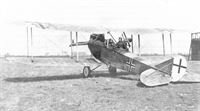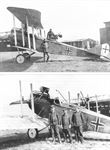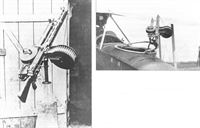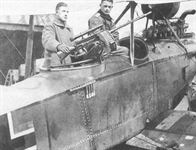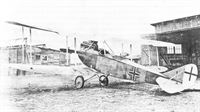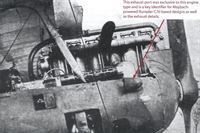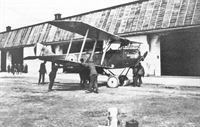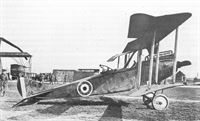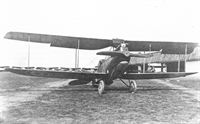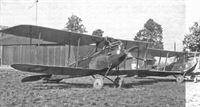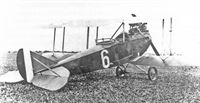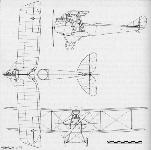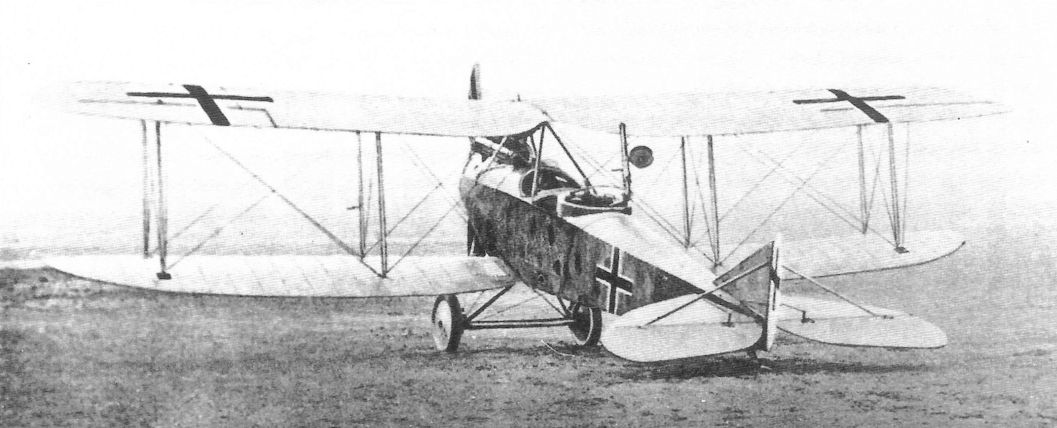
Описание
Страна: Германия
Год: 1917
Long-range reconnaissance and photo-reconnaissance in Rubild model
Варианты
- Rumpler - C.I/C.Ia - 1914 - Германия
- Rumpler - 6B1/6B2 - 1916 - Германия
- Rumpler - C.III/C.V - 1916 - Германия
- Rumpler - C.IV - 1916 - Германия
- Rumpler - C.VII / Rubild Mb - 1917 - Германия
- Rumpler - C.VIII - 1917 - Германия
- В.Кондратьев Самолеты первой мировой войны
- O.Thetford, P.Gray German Aircraft of the First World War (Putnam)
- J.Herris Development of German Warplanes in WWI (A Centennial Perspective on Great War Airplanes 1)
- J.Herris Rumpler Aircraft of WWI (A Centennial Perspective on Great War Airplanes 11)
- M.Dusing German Aviation Industry in WWI. Volume 2 (A Centennial Perspective on Great War Airplanes 85)
-
J.Herris - Rumpler Aircraft of WWI /Centennial Perspective/ (11)
Rumpler Rubild Mb 8186/17 flown by Lt. Oskar Seitz with dual guns for observer
-
J.Herris - Rumpler Aircraft of WWI /Centennial Perspective/ (11)
Rumpler Rubild Mb 8222/17
-
J.Herris - Rumpler Aircraft of WWI /Centennial Perspective/ (11)
Rumpler C.VII with large camera; serial and unit unknown
-
J.Herris - Rumpler Aircraft of WWI /Centennial Perspective/ (11)
Rumpler Rubild 8322/17
-
J.Herris - Rumpler Aircraft of WWI /Centennial Perspective/ (11)
Late-production Rumpler C.VII covered with printed camouflage fabric.
-
J.Herris - Rumpler Aircraft of WWI /Centennial Perspective/ (11)
Late-production Rumpler C.VII covered with printed camouflage fabric.
-
J.Herris - Rumpler Aircraft of WWI /Centennial Perspective/ (11)
Rumpler Rubild Mb 8186/17 flown by pilot Lt. Oskar Seitz. Seitz was instrumental in designing the custom observer's gun mounting that combined a captured Lewis machine gun with the standard Parabellum for additional firepower to defend against Allied fighters. The aircraft has lozenge camouflage fabric on the wings and horizontal tail with painted fuselage and late-style national insignia.The '1' on the fin was a tactical marking.
-
J.Herris - Weird Wings of WWI /Centennial Perspective/ (70)
Rumpler Rubild Mb 8186/17 flown by pilot Lt. Oskar Seitz. Seitz was instrumental in designing the custom observer's gun mounting that combined a captured Lewis machine gun with the standard Parabellum for additional firepower to defend against Allied fighters. The aircraft has lozenge camouflage fabric on the wings and horizontal tail with painted fuselage and late-style national insignia. The 'T' on the fin was a tactical marking.
-
J.Herris - Weird Wings of WWI /Centennial Perspective/ (70)
Rumpler Rubild Mb 8186/17 (1917)
-
J.Herris - Rumpler Aircraft of WWI /Centennial Perspective/ (11)
More details of the custom double gun mount fitted to Rumpler Rubild Mb 8186/17.
-
J.Herris - Development of German Warplanes in WWI /Centennial Perspective/ (1)
The crew of a high-flying Rumpler get a last-minute briefing before their mission. Face protection was essential to prevent frostbite at the extreme altitudes at which these aircraft flew their missions, which could last up to six or seven hours. The observer must be a good marksman because his gun has a telescopic sight for defending the aircraft at long range.
-
J.Herris - Rumpler Aircraft of WWI /Centennial Perspective/ (11)
Another Rumpler observer whose gun has a telescopic sight.
-
J.Herris - Rumpler Aircraft of WWI /Centennial Perspective/ (11)
Both ailerons of Rumpler C.VII 8107/17 are drooping, indicating the control cables are disconnected. Late-style national insignia date the photo in 1918.
-
A.Imrie - German Naval Air Service /Arms & Armour/
This Rumpler C VII, C8179/17, was on the strength of the Seefrontstaffel (Seefrosta). Flown by Leutnants Voigt and Rowehl, it carried out many long-range reconnaissance flights, some of over three hours' duration, extending to the English coast, into the Thames Estuary and the Channel. Undertaken in conditions of good visibility, such forays gathered much information concerning shipping movements, especially activities on the coastal explosive mine net barrages that protected the safe lanes used by Allied shipping.
-
J.Herris - Rumpler Aircraft of WWI /Centennial Perspective/ (11)
Another view of Rumpler Rubild Mb 8186/17 flown by pilot Lt. Oskar Seitz.
-
M.Dusing - German & Austro-Hungarian Aero Engines of WWI. Vol.3 /Centennial Perspective/ (66)
Rumpler Rubild Mb 8222/17 was powered by the Maybach Mb IVa; it landed in Switzerland at the end of the war, perhaps in preference to delivering the aircraft to the Allies.
-
M.Dusing - German Aviation Industry in WWI. Volume 2 /Centennial Perspective/ (85)
Rumpler C.VI Rubild (1917)
-
J.Herris - Weird Wings of WWI /Centennial Perspective/ (70)
Rumpler Rubild 8322/17 in factory camouflage and wearing the straight-sided 1918 national insignia.
-
M.Dusing - German Aviation Industry in WWI. Volume 2 /Centennial Perspective/ (85)
Rumpler C.VII (1917)
-
Журнал - Flight за 1918 г.
The C. IV-type Rumpler biplane fitted with a 250 h.p. Maybach engine.
-
J.Herris - Rumpler Aircraft of WWI /Centennial Perspective/ (11)
Late-production Rumpler C.VII covered overall with printed camouflage fabric.
-
J.Herris - Development of German Warplanes in WWI /Centennial Perspective/ (1)
Lt.d.R. Karl Kerner (at right) and Uffz. Prantzsch (at left with laurel wreath) of FA(A) 282 stand in front of their high-altitude Rumpler photoreconnaissance Rumpler, perhaps a Rubild, after their 100th mission. Kerner wears an electrically-heated flying suit. The wires hanging from the suit are clearly visible. Later Rumplers deleted the elegant propeller spinners of the early models and were actually faster due to reduced drag. Air intakes to supply additional air for the engine are on both sides of the nose.
-
M.Dusing - German & Austro-Hungarian Aero Engines of WWI. Vol.3 /Centennial Perspective/ (66)
The 300 h.p.Maybach engine, installed in the Rumpler C.4 biplane.
This exhaust port was exclusive to this engine type and is a key identifier for Maybach-powered Rumpler C.IV-based designs as well as the exhaust details. -
M.Dusing - German Aviation Industry in WWI. Volume 2 /Centennial Perspective/ (85)
Rumpler C.VII Rubild Mb (1917)
-
J.Herris - Rumpler Aircraft of WWI /Centennial Perspective/ (11)
This early-production Rumpler C.VII in Allied hands wears painted camouflage.
-
J.Herris - Rumpler Aircraft of WWI /Centennial Perspective/ (11)
Late-production Rumpler C.VII 7927/18 in British hands after the Armistice.
-
J.Herris - Rumpler Aircraft of WWI /Centennial Perspective/ (11)
Late production Rumpler Rubild Mb 12212/18 in British hands after the war. It has the late factory finish of overall lozenge printed fabric.
-
J.Herris - Rumpler Aircraft of WWI /Centennial Perspective/ (11)
Late production Rumpler Rubild Mb 12212/18 in British hands after the war. Doubtless this was a welcome opportunity for some British fighter pilots to finally get a close look at an airplane type few of them had ever seen at close range due to its exceptional ceiling and speed at altitude.
-
C.Owers - Hansa-Brandenburg Aircraft of WWI. Volume 1 - Landplanes /Centennial Perspective/ (17)
Late-production Rumpler Rubild Mb 7955/18 and a Brandenburg C.I of the Czechoslovakian air arm. Typical of the early airforces of the nations that emerged after WWI, the Czechoslovaks used whatever aircraft they could obtain.
The German Rumpler C.IV in its various versions with different engines was the best German long-range reconnaissance plane. The Rubild Mb (shown here [supplied to Czechoslovakia postwar]) with its high-altitude Maybach IVa engine was the ultimate development of the aircraft and was seldom intercepted by Allied fighters due to its high speed and ceiling. These aircraft even over-flew England during the war.Другие самолёты на фотографии: Hansa-Brandenburg C.I - Германия - 1915
-
J.Herris - Rumpler Aircraft of WWI /Centennial Perspective/ (11)
Rumpler Rubild Mb 8231/17 in French hands postwar.
-
A.Olejko - War Wings Over Galicia 1918-1919 /Aeronaut/
Daily service... Rumpler C.VII with nose painted red and white surrounded by pilots from the 1st Grand Poles Air Squadron. (collection of the Air Force Museum in Dublin)
-
J.Herris - Rumpler Aircraft of WWI /Centennial Perspective/ (11)
A Rumpler C.VII with Swastika personal marking and massive camera between the cockpits.
В.Кондратьев Самолеты первой мировой войны
Румплер C-VII / RUMPLER C-VII
Для выполнения задач стратегической фоторазведки Эдмунд Румплер установил на C-IV наиболее высотный немецкий мотор "Майбах" с повышенной степенью сжатия. Благодаря этому практический потолок достиг рекордной величины 7300 метров. Для работы на такой высоте пилот и летнаб получили кислородные приборы и комбинезоны с электрообогревом. Фотосъемка осуществлялась автоматическим фотоаппаратом "Герц" с электроприводом. Самолет получил обозначение C-VII и название "Рубильд" (сокращение от "Румплер-фотограф").
В последние недели войны "Рубильды", недоступные для вражеских зениток и истребителей, доставили в немецкие штабы немало ценной развединформации. Но на фоне катастрофически ухудшающегося положения Германии это уже не имело никакого значения.
ДВИГАТЕЛЬ
"Майбах", 240 л.с. (C-VII).
ВООРУЖЕНИЕ
1 турельный "Парабелум", а также - до 100 кг бомб.
ЛЕТНО-ТЕХНИЧЕСКИЕ ХАРАКТЕРИСТИКИ
C-VII
Размах, м 12,7
Длина, м 8,4
Сухой вес, кг 1050
Взлетный вес, кг 1630
Скорость максимальная, км/ч 175
Время набора высоты, м/мин 2000/5
Потолок, м 7300
Описание:









